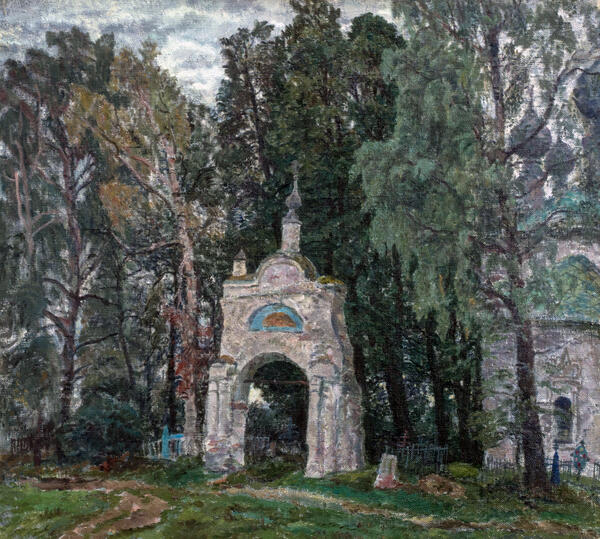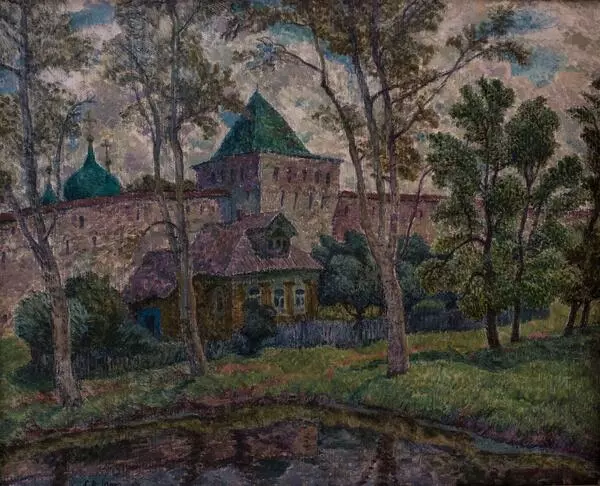In his painting “Fading Day”, the artist Vyacheslav Stekolshchikov depicted one of the views of the city of Smolensk. A wall of the Smolensk Kremlin and church cupolas are illuminated by sunset. On the left side of the picture, the middle ground shows houses and people next to them. There are also two women in the foreground. There is a big pond in front of the Kremlin where trees and bushes grow along its shores.
Smolensk Kremlin became one of the largest fortresses in Russia in the late 16th century — the early 17th century. It was designed by a famous Moscow architect Fyodor Kon’. Not only local people took part in its construction but also workers from all over Russia. Boris Godunov — the native of Smolensk and the future Russian tsar, at that time one of the close boyars of Ivan Grozny — was present at the foundation stone ceremony. “The wall we have built is so magnificent that there are no words to describe its beauty, there is no place like this in the whole world; the Smolensk wall will become the jewel of the whole Russia, like a precious necklace on the neck of a boyar’s wife, and let our enemies get jealous and us be proud of our Moscow government, ” wrote Godunov to Tsar about that day.
The fortress, despite its size, was finished in just 7 years. It included 38 towers, and 9 of them had gates to the main city roads. The towers were attached to the 10-meters-high sections of the wall. There were three tiers as a defense and a complex system of stairs that made it possible to go through the tiers without leaving the fortress or getting downstairs.
At the beginning of the 17th century, Smolensk was besieged by the troops of the Polish King Sigismund III. The fortress was shot with cannonballs and its walls suffered heavily. Later, in the 19th century, some fortifications were exploded by Napoleon’s Army. As time went on, the rest of the structures fell into disrepair and then either collapsed or were unbricked. There were storage facilities in the preserved towers, and in the 20th century, there were museum halls and residential accommodations. Only 14 of 38 towers have been preserved to this day and another four were reconstructed.
Smolensk Kremlin became one of the largest fortresses in Russia in the late 16th century — the early 17th century. It was designed by a famous Moscow architect Fyodor Kon’. Not only local people took part in its construction but also workers from all over Russia. Boris Godunov — the native of Smolensk and the future Russian tsar, at that time one of the close boyars of Ivan Grozny — was present at the foundation stone ceremony. “The wall we have built is so magnificent that there are no words to describe its beauty, there is no place like this in the whole world; the Smolensk wall will become the jewel of the whole Russia, like a precious necklace on the neck of a boyar’s wife, and let our enemies get jealous and us be proud of our Moscow government, ” wrote Godunov to Tsar about that day.
The fortress, despite its size, was finished in just 7 years. It included 38 towers, and 9 of them had gates to the main city roads. The towers were attached to the 10-meters-high sections of the wall. There were three tiers as a defense and a complex system of stairs that made it possible to go through the tiers without leaving the fortress or getting downstairs.
At the beginning of the 17th century, Smolensk was besieged by the troops of the Polish King Sigismund III. The fortress was shot with cannonballs and its walls suffered heavily. Later, in the 19th century, some fortifications were exploded by Napoleon’s Army. As time went on, the rest of the structures fell into disrepair and then either collapsed or were unbricked. There were storage facilities in the preserved towers, and in the 20th century, there were museum halls and residential accommodations. Only 14 of 38 towers have been preserved to this day and another four were reconstructed.





